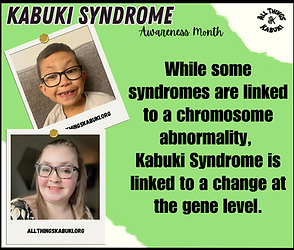



ANNOUNCEMENTS






KABUKI AT A GLANCE
Kabuki syndrome, first described in Japan in 1967, became a formal diagnosis in 1981. Kabuki syndrome was originally referred to as Kabuki make-up syndrome (KMS). It would also be named (and less commonly referred to as) Niikawa-Kuroki syndrome, after the founding doctors. Kabuki make-up syndrome would later be shortened to Kabuki syndrome.
Kabuki syndrome is a rare genetic disorder originally believed to affect approximately 1 in 32,000 births worldwide. Some geneticists believe the occurrence rate may be as high as 1 in 15,000 births, however this data is unconfirmed. The term genetic means an individual is born with a condition and the cause of that condition resides in his or her genetic makeup. Genetic disorders can be passed down (inherited) or spontaneous (de novo).
The first gene recognized to be responsible for Kabuki was discovered in 2010 at the University of Washington. There are currently two genes identified as the cause for Kabuki syndrome. Mutations on KMT2D, formerly known as MLL2, are believed to affect as many as 75% of those diagnosed. Mutations on KDM6A are less common and present in approximately 5% of cases. Studies have shown there are likely additional genes yet to be identified. Kabuki syndrome can be clinically or genetically diagnosed by a Geneticist.
Children and adults affected by Kabuki experience a variety of symptoms, some of which may include: mild to moderate intellectual impairment, growth delays, low muscle tone, feeding difficulties, heart defects, cleft palate, skeletal abnormalities, visual impairments, hearing impairments, seizures, communication delays, and autistic-like behaviors. Kabuki syndrome affects each individual differently.
Kabuki syndrome does not shorten ones life span, however underlying conditions may.
.png)
